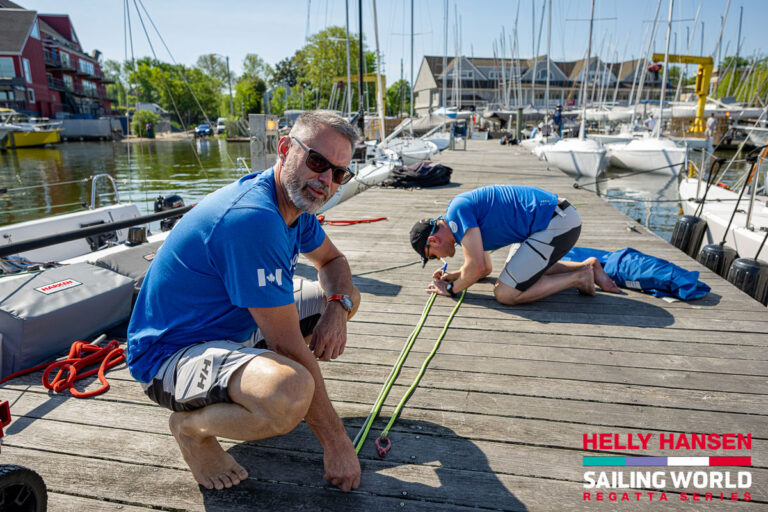
When I get on a boat to coach, I’m often surprised to find the least experienced crewmember in the pit. The theory seems to be that the pitman should simply take directions, like a short-order cook. While this method might get them around the racecourse, it will undoubtedly lead to a lot of noise, distraction, and less polished boathandling than if a more experienced team member were in the pit. Top grand-prix programs have pitmen that run the middle of the boat and are constantly communicating with the bow, trimmers, and afterguard. They’re a vital link and proactive players in decisions.
The pitman’s preparation starts long before the boat leaves the dock. To be able to handle all the different scenarios that might come during a race I start monitoring the weather a few days out from an event. I want to know if we’ll be racing in heavy or light wind, if it might rain, and what the temperature will be, and I relay it to other members of the team. I’ll also determine who our main competition will be, which allows me to anticipate how starts and mark roundings might go. Current is another item I have on my checklist because it will give me a better idea of what the overall racecourse strategy might be.
I also want to know about any new or specialty sails, such as a Code Zero or genoa staysail, and what we’ll need to do to check these sails during our practice time. Finally, I always make it a point to read the sailing instructions as soon as they’re available. As pitman, I need to know the timing of races, starting sequences, penalties, etc., and I should be able to answer, on the spot, any question about the SIs.
The pitman should arrive at the boat early and make sure the pit is prepared: Winch handles, tape, markers, shackles, snatch blocks, and anything else should be placed in their designated locations. Make sure halyards and other control lines are all run properly through the clutches and organizers, and have stopper knots. Make sure the tails are long enough so that, if they get pulled tight to the jammer, you can pull them back while under load. Inspect the sails to confirm they’re all on board, and check that the correct sails are in their bags and properly labeled. Begin talking with your bow, mast, and trimming teammates to make sure their areas are properly rigged, and discuss the type of maneuvers you’ll be doing. If you’re doing a point-to-point race, you’ll want to discuss which way you’ll round marks, whether you need peel sheets rigged, staysail sheets run, or hardware in place for outboard leads.
Once sailing, remember that you’re the main communication link between the ends of the boat. Don’t be afraid to ask people to keep the noise down if you’re having a hard time hearing the bowman or the back of the boat. I ask the guys on the bow if they can hear and tell the tactician or navigator to speak up if I’m having a hard time hearing them.
Be proactive with your communication and don’t be afraid to ask for the information you need: For example, will it be a bear away, jibe set, or tack set? Do they want the staysail immediately after the set, or will it be a quick jibe? Then, make sure the team up front gets the information they need as well. This communication needs to be clear and concise, using as few words as possible. You always want to receive a response, such as “OK” or “Copy.”
If you sense the afterguard is having a hard time figuring out the best way to do a maneuver, such as a leeward mark rounding, it’s OK to tell them what the guys up front would like to do or what they’re already set up for. It’s also critical that you let the afterguard know what maneuvers you can’t do in certain situations, such as switching from a bear away to a jibe set too close to the top mark or calling for a last-second jibe before doing a spinnaker drop.
One scenario when the pitman must be proactive is while approaching the leeward mark when the person making the sail choices is trying to decide which jib to use on the next leg. This call has to be made as late as possible, but it’s important the pitman knows when “late as possible” really is. I like to give him a cutoff time such as “we need a decision in 30 seconds.” This usually helps him make the choice.
Keep your eyes out of the boat as much as you can. Monitor the wind and competition to help anticipate what your future moves might be. For example, if you see the wind shifting to the right during a beat, start thinking about what needs to get done if the call to jibe set is made, or at least be ready for a quick jibe.
Make sure the rest of the bow team gets this information. Many times the bow guys are too busy to take a good look around, or they might be in the sewer packing the kite. The same principal applies when you see the wind building or dropping around you. Anticipate that you might be switching to a different sail for the next leg and alert the rest of the bow team so they’re ready when the call is made.
Another tool you can use to help anticipate future moves is to see what the competition around you is setting up for. If you’re covering a boat behind you, anticipate the kind of spinnaker set or takedown they’re rigging up for so you can match. Also watch them on the downwind leg to see if they pull a new jib on deck, and ask your sail trimmers if they’re thinking of switching as well.
Having this situational awareness will be a huge help to you in the pit, but it’s also a huge help for your teammates. Visualize all your essential moves as much as you can so you have them down cold. You shouldn’t have to think about what to do during a maneuver if you’ve got all your moves memorized. When a bowman has his head down while hooking up a spinnaker, a good pitman will be able to tell him how much time he’s got to the mark while setting up the pit at the same time.
Strive to be an open-minded leader on the team. Be organized, focused, and motivated to help the team win. Try to think ahead of the boat and anticipate what will happen on the racecourse. Maintain good situational awareness and keep your teammates focused by feeding them information. Be as prepared as possible for what might happen on a race day and work hard to be an effective communicator. These skills make you an extremely valuable person on the boat, and they will also make racing in the pit a whole lot more fun.









